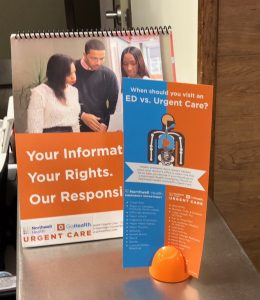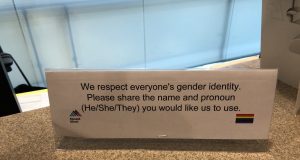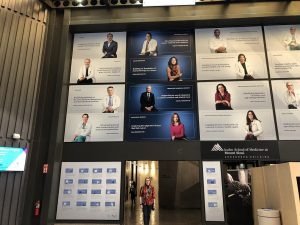 What an incredible experience New York was! Visits included 2 Urgent Care centres, 4 Pharmacies (which have to be seen to be believed), a Physical Therapy centre (Physio) and the famous Mount Sinai hospital. From my 3-state tour I now have 35 pages of notes (and 400 photos) but to summarise, my top 5 learnings were:
What an incredible experience New York was! Visits included 2 Urgent Care centres, 4 Pharmacies (which have to be seen to be believed), a Physical Therapy centre (Physio) and the famous Mount Sinai hospital. From my 3-state tour I now have 35 pages of notes (and 400 photos) but to summarise, my top 5 learnings were:
- Health care roles are evolving
It is common for patients to see at least 3 clinicians in one visit. A patient in the US may see a Medical Assistant, Licenced Practical Nurse (LPN), Registered Nurse (RN), Nurse Practitioner (NP), Physician’s Assistant (PA), Primary Care Physician or Specialist Physician. There are also OT assistants, Physical Therapy Assistants (Physio assistants) and all of these additional roles have a variety of qualifications and are licensed/regulated by each state as well as a national governing body. - Each visit is physically centred around the patient rather than the clinicians.
For example, it is common for patients to be taken to a consulting room and each clinician comes to the patient rather than a doctor or nurse calling a patient to their own consulting/treatment room. - Medical software is used as a clinician and patient communication tool.
Technology encountered on this visit were Epic & Cerner (major vendors) as well as specific programs: Open Notes & My Chart (patient portals), LG, Therapute & ClinicSource. Challenges related to medical software, as reported by staff we interviewed, included: variability in user-friendly or discipline-specific screens, interest/personality of user, training & support, needing additional add-on programs and lack of interoperability. However, team-based care and protocols drive the collection of a large volume of data. In addition, electronic communication combined with medico-legal risk minimisation strategies, result in a much higher level of data collection and currency of data than is commonly seen in Australia. - Many healthcare facilities are sharing the entire electronic medical record with the patient.
Patients are actively encouraged to access their own medical record via a web portal or patient app. They are encouraged to review recommendations and track their own healthcare improvements via graphs of their own results.  Patient expectations regarding involvement in decisions and ‘customer service’ are high.
Patient expectations regarding involvement in decisions and ‘customer service’ are high.
US citizens are conditioned they have ‘constitutional rights’ and they talk of a right to see their notes, a right to choose their healthcare, challenge treatment options, expect good service etc. This, along with the current state of litigation where patients do not pay unless they win the legal case, seems to drive behaviour. In addition, the right to information means data is used to demonstrate exceptional care eg. the right to choose means doctors such as a surgeon will advertise their low post-op infection rates.
Patient Visit: Urgent Care Facility, New York
Patient Scenario:
Patient Pam’s blood pressure had been slightly high following an infection 8 weeks prior. She had been advised by her usual Primary Care Physician to have her blood pressure checked while on holiday in New York. While in New York she enquired at the hotel as to the closest medical practice and was directed to an ‘Urgent Care’ facility.
Appointment & booking process:
Pam did not call first, she walked to the clinic and following instructions on a sign on the building, buzzed the intercom. She asked if she could see a doctor and the door was buzzed open and Pam was advised to get the lift to the second floor. On arrival the large waiting room was completely empty except for the receptionist.
Cost & Insurance
The receptionist asked if Pam had insurance and when Pam advised her insurance was with Kaiser Permanente she was told they did not accept Kaiser insurance. They accepted Blue Cross, but not Kaiser. Pam asked what the fee would be if not using insurance and was advised it would cost $155.00. Pam was advised she must produce a photo ID to r eceive treatment. Pam decided to proceed with the appointment.
eceive treatment. Pam decided to proceed with the appointment.
New Patient Registration
Pam was given forms to complete which were three pages long and requested significant medical history detail to be completed.
Payment was taken once Pam handed the forms to the receptionist, prior to the consultation.
Consultation 1 – Nurse
Pam was taken into a consulting room and approximately 2 minutes later a Licensed Practical Nurse (LPN) arrived. She quickly entered Pam’s details into her new electronic medical record, checking with Pam as she did. She questioned Pam about her insurance cover and then proceeded to take Pam’s ‘vitals’, writing observations on a piece of paper first before entering them into the computer.
Pam asked how long it would be until she saw the doctor and was advised it would be less than 5 minutes and someone would come into the room shortly.
Consultation 2 – Physician’s Assistant (PA)
A clinician in a white coat with a stethoscope around her neck then walked into the room. She introduced herself as ‘Loreen, a Physician’s Assistant’.
Pam asked if she would be seeing a doctor and Loreen advised there was no doctor on site and she told Pam she would be caring for her today.
Loreen went through Pam’s details on the computer, discussing each medication and medical history item and ticking to verify she had checked each one.
She then asked Pam detail about the original infection.
Loreen (PA) then advised Pam that her blood pressure was within normal range and asked if she had any other concerns. Pam said she needed another prescription for a medication she just had dispensed as she was now spending weekends at her new house in the mountains while still maintaining her existing residence in the city. She was wanting to keep medication at both residences however was unable to re-order online as her electronic medical record noted she had only just had her medication dispensed. Loreen advised that if she wrote a prescription for Pam she would not be able to be to have it dispensed as usual as it would not be a ‘Kaiser prescription’. She advised Pam to order the medication from her usual Primary Care Physician when she returned home.
Pam asked the PA what would have happened had she needed a doctor and was advised “If something happens we call 911, our doctors are on call and there are several hospitals nearby.” She mentioned sometimes there is a doctor working on site and that there are 9 Physician’s Assistants for every 1 doctor.
Patient Pam’s comments
“The entry, having to buzz to get in and then go up two flights of stairs made it all seem a bit scary”.
“They were very friendly until I said I didn’t have the right insurance”.
“That’s the first time I have ever heard of a medical clinic not having a doctor on site”.
“It’s hard to tell who is a doctor and who isn’t these days”.
Clinician’s Perspective:
“Downright dangerous, how can you have an ‘Urgent Care’ facility and no doctor on site?”
“It is just so confusing to patients, everyone looks like a doctor, yet they aren’t. Patients would assume they were a doctor.”
“There is a lot of responsibility on the Physician’s Assistant.”
Practice Management & Health IT Assessment:
- Looked clean and professional, very much like an Australian waiting room. There did not seem to be any other patients on site although with patients waiting in individual rooms rather than sitting in a waiting room this is difficult to determine.
- Patient was seen quickly, and comprehensive data collected quickly. Pam would not have been seen without a ‘picture ID that matched’ and I ascertained this was in case she was an ‘illegal immigrant’.
- Software was specific to the organisation. There was no interoperability with Epic which is Pam’s electronic medical record (with Kaiser Permanente) therefore they were not able to access Pam’s existing comprehensive electronic medical record.
- Pam could have accessed her medical record (kp.org from Kaiser) on her own device and shown the new practice but she said she did not feel confident enough to do that.
Watch my New York study tour videos:
Video 1: Urgent Care facilities, Pharmacies, Physical Therapy centre
Video 2: Mount Sinai Hospital, Pharmacies, Flu Clinic
Read US study tour blog 1: Patient Pam’s visit to Kaiser Permanente Primary Care, Honolulu
Read US study tour blog 2: Patient Ron’s visit to Kaiser Permanente, Specialist Care, Atlanta
Watch my videos from Hawaii & Georgia:
Kaiser Permanente Primary Care Centre, Honolulu
Hospital & Paediatric Allied Health Care Facilities, North Georgia
Allied Health, Rehab and Aged Care facilities, Atlanta,
Cancer Treatment Center of America, Atlanta
Cardiology visit and Orthopaedic procedure, Atlanta
I have so much more I would love to share about this trip including at least 12 more patient stories so let me know if you would like me to speak at an event, write more blogs on this topic or if you are interested in reading a detailed report. A detailed report may take me a while as I am off to train and check on progress with our own Australian medical practices trialling ‘patient-centred medical home’ reform. I am very pleased to say though there is a lot of exciting progress happening in Australia with health IT right at the moment. More detail on that very soon.
With best wishes, Katrina Otto

